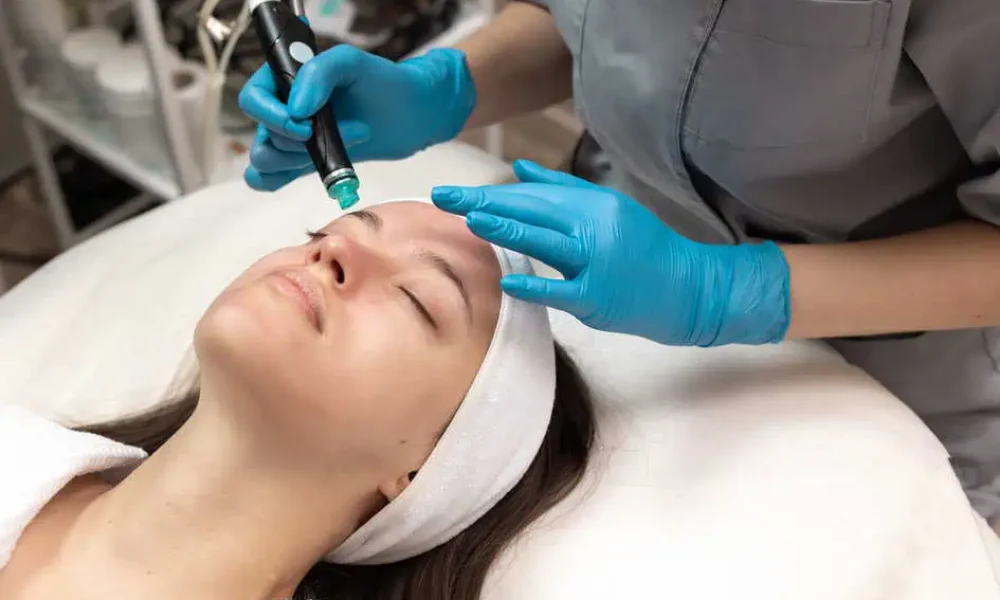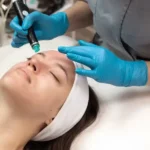We all want a fresh, healthy, just-stepped-out-of-a-spa glow. But when it comes to choosing the right facial treatment, the options can be confusing. Should you go for the traditional deep cleansing facial, or try the more advanced HydraFacial, known for its instant radiance? Both promise to rejuvenate your skin, but they work in very different ways.
Whether your goal is hydration, deep detox, or a red-carpet glow, understanding the difference between these two treatments will help you make the right choice for your skin’s unique needs.
What Is a HydraFacial?
The HydraFacial is a newer, technology-based skincare treatment that combines cleansing, exfoliation, extraction, and hydration, all in one. It’s non-invasive, quick, and requires zero downtime.
At SKIN111, the HydraFacial is performed using an advanced device that uses gentle vacuum suction and specialised serums to deeply cleanse and nourish the skin. The process usually takes 30 to 60 minutes, and clients can return to their day immediately with visibly fresher skin.
Steps in a HydraFacial Treatment:
- Cleansing & Exfoliation: The procedure starts with mild cleansing to remove surface impurities and dead cells, prepping the skin for treatment.
- Gentle Peel: A low-strength glycolic or salicylic acid peel is applied to loosen debris and promote skin renewal.
- Extraction with Vacuum Technology: The HydraFacial device uses patented suction to extract blackheads, whiteheads, and excess oil, without the pain or redness of manual extraction.
- Hydration Infusion: The skin is then infused with hydrating serums packed with antioxidants, peptides, and hyaluronic acid for deep nourishment.
- Protection: Finally, moisturising and protective products are applied to seal in hydration and shield the skin from environmental stress.
Different Types of HydraFacial Treatments
SKIN111 offers several HydraFacial variations tailored to different skin concerns:
- HydraFacial Standard: Ideal for basic deep cleansing and hydration.
- HydraFacial Deluxe: Includes targeted boosters for brightening or anti-ageing benefits.
- HydraFacial Platinum: Combines cleansing, hydration, and lymphatic drainage for complete rejuvenation.
There’s also the HydraCool Facial, performed using a 7-in-1 beauty machine that uses oxygen and water jets to penetrate nutrients into the deeper skin layers. It’s excellent for hydration, blackhead removal, pore reduction, and overall skin improvement.
Other variants like HydraClean, HydraLyft, and HydraBoost focus on specific concerns such as deep cleansing, firming, and intense moisture replenishment.
What Is a Deep Cleansing Facial?
A deep cleansing facial is one of the oldest and most popular skincare treatments. It focuses on removing dirt, oil, and impurities that build up over time, especially in urban environments where pollution and stress take a toll on the skin.
A typical deep cleansing facial includes several manual steps:
- Cleansing and exfoliation: To remove makeup, debris, and dead skin cells.
- Steam: Opens up the pores to loosen blackheads and whiteheads.
- Manual extractions: Remove clogged impurities from the pores.
- Massage: Stimulates blood flow and helps the skin absorb nutrients.
- Mask: A targeted mask soothes, hydrates, or purifies depending on skin type.
However, because it relies on manual exfoliation and extraction, results can vary depending on skin sensitivity and the skill of the beautician. For those with delicate skin, it may sometimes cause mild redness.
HydraFacial vs. Deep Cleansing Facial: The Key Differences
| Feature | Deep Cleansing Facial | HydraFacial |
| Technique | Manual cleansing, steam, and extractions | Machine-assisted with suction and serums |
| Exfoliation | Physical scrubbing or manual peeling | Gentle acid peel with glycolic/salicylic acid |
| Hydration | Depends on the products used | Deep infusion of hydrating serums |
| Results | Cleaner, refreshed skin | Instant glow, smoother texture, improved hydration |
| Downtime | Minimal; possible redness from extractions | None at all |
| Best For | Routine skin care and relaxation | Intense rejuvenation, dull or congested skin |
| Duration | 45–60 minutes | 30–60 minutes |
The biggest difference lies in the method and intensity of results. Deep cleansing facials use manual techniques, while HydraFacials rely on technology to deliver precision care and consistent outcomes.
Who Should Choose a HydraFacial?
The HydraFacial works best for:
- Oily or acne-prone skin that tends to clog easily.
- Dull or uneven skin tone needing a radiance boost.
- Dehydrated skin is craving moisture and nourishment.
- Sensitive or mature skin that can’t tolerate harsh scrubbing or peels.
- Anyone preparing for a special occasion who wants an instant glow.
Because it’s gentle yet effective, the HydraFacial suits almost every skin type, including sensitive and sun-exposed skin. It’s especially beneficial in climates like Dubai, where heat, humidity, and pollution can dull the complexion.
Who Should Choose a Deep Cleansing Facial?
A deep cleansing facial is ideal for:
- Normal to combination skin that needs regular upkeep.
- First-time facial clients who want a relaxing introduction to skincare.
- Those with occasional breakouts or clogged pores.
- People looking for an affordable, low-tech treatment for maintenance.
The Bottom Line
Both the HydraFacial and deep cleansing facial can leave your skin looking refreshed; the difference lies in the approach and the depth of results.
If you want deep relaxation and gentle maintenance, the classic deep cleansing facial is a great choice. But if your skin needs intense hydration, detoxification, and an instant glow, the HydraFacial stands out as the more advanced, results-driven option.
At the end of the day, your skin type, goals, and schedule will determine which one is right for you. What matters most is choosing a treatment that keeps your skin healthy and nourished.






